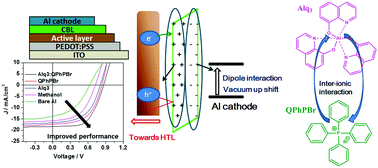Improved fullerene-free polymer solar cells using a rationally designed binary mixed solution of an electron extracting layer†
Abstract
In continuation of the progressive development of cathode interfacial engineering for successfully improving the power conversion efficiency (PCE) of organic solar cells (OSCs), a breakthrough strategy of combining two small organic materials named Alq3 (aluminum tris(8-hydroxyquinolinate)) and QPhPBr (tetraphenylphosphonium bromide) in one solution acting as a cathode interfacial layer (CIL) has been performed. The strong electron extracting property of Alq3 determined previously and the crucial process of vacuum deposition led to our concept to propose this idea of a mixed binary solution processing technique. We successfully delivered a high performance of PCE above 11% with an increased Voc (0.860 V), Jsc (18.38 mA cm−2) and FF (69.85%) using the combination of Alq3 with QPhPBr as a CIL fabricated using a conventional device structure with PBDB-T:ITIC-Th as the blended active layer. The PCE is 2.5-fold higher than the reference device of bare Al cathode (4.38% PCE). Moreover, the binary mixed solution of CIL has shown a better performance than the Ca/Al based device with a PCE value 1.5 times higher than the value of 7.32% of the Ca/Al device. Their attractive performance has promoted a new challenge for new upcoming bulk-heterojunction OSCs in future prospects.



 Please wait while we load your content...
Please wait while we load your content...